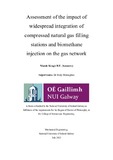Assessment of the impact of widespread integration of compressed natural gas filling stations and biomethane injection on the gas network
Date
2023-01-16Author
Keogh, Niamh
Metadata
Show full item recordUsage
This item's downloads: 49 (view details)
Abstract
The research in this thesis has explored, investigated and analysed the
integration of biomethane production and injection facilities and compressed
natural gas (CNG) filling stations in to gas distribution networks, through
technical, economic and environmental modelling. First, a simulation of a gas
distribution (Dx) network was built to investigate the impacts of technical
limits imposed by gas network operation and safety standards on the quantity
of biomethane which can be injected. The Dx network simulation also
incorporates annual consumer demand profiles based SCADA data, taking
into consideration the seasonal variations in the gas demand. Scenarios of
maximum, minimum and no demand at a grid-connected compressed natural
gas (CNG) filling station were computed, to determine the impact of the
addition a CNG filling station to the gas network. The location of the
biomethane production and injection facility is also analysed. The results
calculated the grid capacity to accept biomethane on an hourly basis over the
course of a year. This data was used to determine a range of possible plant
sizes for each potential facility location and CNG demand scenario. Next, a
spatially explicit geographical information systems model was created to map
the distribution of feedstocks suitable for biomethane production in the
surrounding area and determine the transport distances. These two submodels
fed into a techno-economic assessment that calculated the levelised cost of
energy and net present value for each configuration, and techno-econo environmental models that calculated the total cost of carbon abatement for
each configuration. Key parameters for both of these models include the
capital and operating cost of the anaerobic digester, upgrader, injection
facility and CNG station, the feedstock transportation cost, and the potential
incentives for biomethane and bioCNG. The techno-econo-environmental
model also incorporates a life cycle assessment for the production and use of
biomethane as either a fuel for residential heating or a fuel for CNG heavy
goods vehicles, to determine the overall environmental costs and benefits.
This work contributes to gas grid, biomethane and bioCNG research, by
presenting a novel method of modelling the integration of biomethane
injection facilities and CNG filling stations into gas Dx networks, to assess
the overall technical, economic and environmental impacts.


